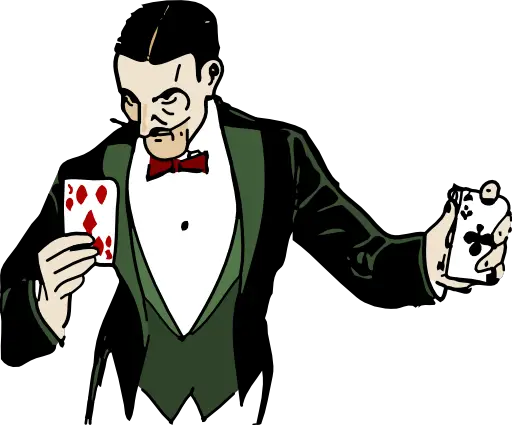Support our educational content for free when you purchase through links on our site. Learn more
🤯 What is a Mind Trick? Unmasking the Illusion and Unleashing Your Inner Magician [2024]
Ever been left utterly baffled by a friend’s seemingly impossible prediction, or felt your mind bend with a simple question that left you second-guessing your own senses? You’re not alone. We’ve all been tricked by the sly art of the mind game, and it’s often more captivating than any sleight of hand magic trick. Welcome to the world of mind tricks, where perception is reality, and the only limit is your imagination. In this article, we’ll dive into the mind-bending world of psychological illusions, cunning persuasion, and the power of suggestion.
Quick Answer
Here’s a glimpse into the captivating world of mind tricks:
- Mind tricks involve using psychology, suggestion, and observation to influence others’ perceptions, thoughts, or actions. These techniques are often used in entertainment but can also be found in daily life.
- These “tricks” exploit our brains’ natural tendencies and biases, such as our reliance on cognitive shortcuts, our susceptibility to suggestion, and our susceptibility to misdirection. These are the building blocks of mentalism and everyday persuasion.
- Learning mind tricks can be both fascinating and empowering. It can be as simple as mastering basic tricks with card tricks or as involved as delving into the fascinating world of magic psychology.
Ready to unleash your inner magician? Let’s explore the mind tricks that are bending reality as we know it!
Table of Contents
- Quick Tips and Facts
Quick Tips and Facts - The Psychology of Mind Tricks: Unmasking the Illusion
The Psychology of Mind Tricks: Unmasking the Illusion - Types of Mind Tricks: A Journey Through the Mind’s Labyrinth
Types of Mind Tricks: A Journey Through the Mind’s Labyrinth - Mind Tricks in Everyday Life: The Hidden Persuaders
Mind Tricks in Everyday Life: The Hidden Persuaders - The Ethics of Mind Tricks: When Deception Becomes Manipulation
The Ethics of Mind Tricks: When Deception Becomes Manipulation - Learning Mind Tricks: Unleashing Your Inner Magician
Learning Mind Tricks: Unleashing Your Inner Magician - Mind Tricks in Popular Culture: From Movies to Magic Shows
Mind Tricks in Popular Culture: From Movies to Magic Shows - Conclusion
Conclusion - Recommended Links
Recommended Links - FAQ
FAQ - Reference Links
Reference Links
1. Quick Tips and Facts 🤯
Want to impress your friends with your mind-reading abilities or leave them speechless with a baffling prediction? Mind tricks are the way to go! ???? Here are a few quick tips and facts:
- Psychology is Key: Most mind tricks aren’t supernatural; they leverage psychology, suggestion, and observation. It’s about understanding how the brain works and using that to your advantage.
- Practice Makes Perfect: Like any skill, mind tricks require practice. Start with simple tricks and gradually work your way up to more complex ones.
- Presentation is Everything: The way you present a trick is just as important as the trick itself. Be confident, build suspense, and maintain eye contact. Remember, you’re a mentalist, not a magician! 😉
2. The Psychology of Mind Tricks: Unmasking the Illusion 🧠
Ever wondered how those seemingly impossible mind-reading feats are achieved? The answer, dear reader, lies in the fascinating world of psychology! Most mind tricks rely on cleverly exploiting the brain’s natural tendencies and biases. Let’s delve into some of these psychological underpinnings:
Cognitive Biases: Our Brain’s Shortcuts
Our brains love taking shortcuts, using pre-existing patterns and assumptions to process information quickly. While efficient, these shortcuts, known as cognitive biases, can be manipulated. For instance, the “availability heuristic” makes us overestimate the likelihood of events we can easily recall, often due to their vividness or recent occurrence. A skilled mentalist can use this bias to their advantage, making you believe something is more common than it truly is.
The Power of Suggestion: Planting Seeds of Thought 🌱
Ever noticed how a simple suggestion can take root in your mind, influencing your thoughts or actions? That’s the power of suggestion at play! A master mentalist subtly guides your focus, subtly leading you towards a predetermined outcome.
Misdirection and Attention Manipulation: The Art of Illusion
Remember that classic magician’s saying, “The hand is quicker than the eye?” Well, in the realm of mind tricks, it’s more like “The mind is quicker than the eye.” By strategically diverting your attention, a skilled mentalist can make you miss crucial details, enhancing the illusion.
3. Types of Mind Tricks: A Journey Through the Mind’s Labyrinth 🗺️
The world of mind tricks is vast and varied, encompassing a spectrum of illusions that play on perception, memory, and logic. Let’s explore a few intriguing categories:
Psychological Illusions: Bending Your Perception of Reality
Prepare to question your senses! Psychological illusions exploit the way our brains process sensory input. Remember that infamous blue/black or white/gold dress that divided the internet? That was a prime example of a visual illusion messing with our color perception.
Memory Feats: Playing Tricks on Your Recollection
Ever walked into a room only to forget why? Don’t worry, it happens to the best of us! Our memories are far from perfect. A cunning mentalist can use techniques like suggestion and misdirection to implant false memories or make you doubt your own recollections.
Predictions: Peering into the Future? 🔮
From predicting the outcome of a coin toss to seemingly knowing your deepest thoughts, predictions lie at the heart of many mind-bending performances. But remember, true precognition is a topic for parapsychologists. Mentalists use a combination of observation, deduction, and psychological manipulation to create the illusion of foresight.
Subliminal Messaging: Whispers to the Subconscious 🤫
Ever felt inexplicably drawn to a certain product or brand? You might have been a target of subliminal messaging! By embedding subtle images or messages below the threshold of conscious awareness, marketers and influencers can influence your preferences without you even realizing it.
4. Mind Tricks in Everyday Life: The Hidden Persuaders 🕵️
Think mind tricks are confined to the stage or screen? Think again! From advertising to social interactions, these subtle forms of influence permeate our daily lives.
The Art of Persuasion: Getting What You Want
Ever wondered how some people seem to effortlessly get their way? They might be masters of persuasion, employing subtle mind tricks to influence your decisions. Techniques like framing (presenting information in a way that evokes a desired response), reciprocity (creating a sense of obligation), and scarcity (highlighting limited availability) are often used to nudge you towards a particular choice.
Body Language: The Silent Influencer
Our bodies speak volumes, often betraying our true thoughts and feelings, even when we try to mask them. A keen observer can pick up on subtle cues like micro-expressions, posture, and gestures to gain insights into your emotional state and potential intentions. Learning to read body language can be an invaluable tool in social and professional settings alike.
Negotiation and Influence: Mastering the Art of the Deal
Whether you’re negotiating a salary raise or simply trying to convince your friend to watch your favorite movie, understanding the principles of influence can significantly improve your chances of success. By building rapport, establishing credibility, and framing your arguments effectively, you can sway opinions and achieve your desired outcomes.
5. The Ethics of Mind Tricks: When Deception Becomes Manipulation 🤔
Ah, the age-old dilemma: With great power comes great responsibility. But where do we draw the line between harmless fun and unethical manipulation when it comes to mind tricks?
Entertainment vs. Exploitation: The Magician’s Code
Magicians and mentalists often adhere to a code of ethics, using their skills for entertainment purposes while respecting the audience’s trust. However, like any art form, the potential for misuse exists. Exploiting someone’s vulnerability for personal gain is unethical and potentially harmful.
The Power of Persuasion: When Does It Cross the Line?
Persuasion, in itself, isn’t inherently good or bad. We use it daily to communicate, share ideas, and influence decisions. It’s when persuasion is used to deceive, coerce, or manipulate that it becomes ethically problematic.
Informed Consent: The Key to Ethical Mind Games
In the context of performance or entertainment, obtaining informed consent is crucial. Audiences should be aware that they’re witnessing illusions, not genuine supernatural powers. Transparency helps maintain trust and ensures everyone’s on the same page.
6. Learning Mind Tricks: Unleashing Your Inner Magician 🧙
Ready to dazzle your friends with your newfound mental prowess? Here’s the path to unlocking your inner mind magician:
Start with the Basics: Building a Foundation 🧱
Begin with simple tricks that rely on basic psychology and observation. Card tricks are a great starting point, as they teach you misdirection techniques, sleight of hand, and psychological subtleties.
Study the Masters: Learning from the Best ✨
Just like aspiring musicians learn from legendary artists, aspiring mentalists can benefit from studying the techniques of renowned performers. Watch videos of famous mentalists like Derren Brown, Banachek, and Max Maven. Analyze their performances, paying close attention to their body language, delivery, and psychological strategies.
👉 CHECK PRICE on:
Practice, Practice, Practice: Honing Your Craft
Mastery requires consistent effort. Practice your tricks regularly, even in front of a mirror, to refine your technique and build confidence. Seek feedback from trusted friends or mentors to identify areas for improvement.
7. Mind Tricks in Popular Culture: From Movies to Magic Shows 🎬
Mind tricks have captivated audiences for decades, finding their way into various forms of popular culture:
Cinematic Illusions: The Matrix, Inception, and Beyond
From bending spoons with their minds to implanting ideas into the subconscious, movies have often depicted mind tricks as fantastical superpowers. Films like “The Matrix,” “Inception,” and “Limitless” explore the captivating possibilities—and potential dangers—of harnessing the full potential of the human mind. For fans of the fantastical, our article about 15 Jedi Mind Trick Examples from Movies: The Force of Influence 2024 delves into the captivating world of mind control in a galaxy far, far away. 🌌
Television’s Mentalists: From “The Mentalist” to “Psych”
Television shows like “The Mentalist,” “Psych,” and “Lie to Me” have brought the art of observation, deduction, and psychological manipulation into our living rooms. While often exaggerated for dramatic effect, these shows highlight the power of nonverbal communication, cognitive biases, and the subtle cues that can reveal our true thoughts and intentions.
Stage Magic and Illusion: The Enduring Allure
From grand illusions like levitation to close-up coin and money tricks, stage magic continues to enchant audiences worldwide. While many of these tricks rely on sleight of hand, misdirection, and carefully engineered apparatus, the best magicians weave in elements of psychology and suggestion to create truly unforgettable experiences.
Want to explore the world of magic further? Check out our categories on magic psychology, levitation, and even kids magic. You’ll find a treasure trove of information and inspiration to spark your curiosity and unleash your inner magician! ✨
Conclusion
So, there you have it! Mind tricks, those fascinating feats of deception and persuasion, are a blend of psychology, observation, and a dash of showmanship. While some might be quick to dismiss them as mere parlor tricks, they offer a unique window into the workings of our own minds. From the subtle biases that shape our perceptions to the power of suggestion that can influence our choices, understanding mind tricks can empower us to better navigate the world around us, whether it’s in the realm of social interactions, marketing, or simply navigating the daily ups and downs of life. Remember, the power of the mind is vast and far-reaching, so use it responsibly and with a healthy dose of curiosity! 🌟
Recommended Links
👉 Shop Mentalism Products on:
Books on Mentalism and Mind Tricks:
- “Mind Magic: Secrets From the World’s Greatest Mentalists” by Banachek: Amazon
- “The Art of Mentalism: Techniques for Performing Amazing Mind-Reading Tricks” by Luke Jermay: Amazon
- “Psychological Sleights of Mind: A Guide to Mentalism” by Richard Osterlind: Amazon
FAQ
What is a mental trick?
A mental trick, also known as a mind trick, is a technique used to influence someone’s thoughts, perceptions, or behavior, often by exploiting psychological principles.
Read more about “15 Jedi Mind Trick Examples from Movies: The Force of Influence … 💫”
What is the mind trick effect?
The “mind trick effect” is the outcome of a successful mind trick, where the target of the trick is led to believe something that isn’t true, or is made to act in a way they wouldn’t normally.
Read more about “How to Trick the Human Mind: 8 Mind-Blowing Techniques Revealed … 🧠”
What is an example of the Jedi mind trick?
In the Star Wars universe, the Jedi Mind Trick is a Force ability where the user influences the thoughts of another person, often to make them comply with a request. For example, Jedi Master Obi-Wan Kenobi used a mind trick to convince Stormtroopers that they “are no match” for him, causing them to momentarily forget their duty and allow him to pass.
What are some other real-life examples of mind tricks?
There are many examples of mind tricks used in everyday life, often without people being consciously aware of it. Here are a few:
- Negotiation: Using framing to present information in a way that makes a particular option seem more appealing.
- Marketing: Creating a sense of scarcity to persuade people to buy a product.
- Social Interactions: Using flattery to make someone feel good and more likely to comply with a request.
Read more about “How to Do the Mind Reading Number Trick? … 🔮”
What is the meaning of brain trick?
The term “brain trick” is often used interchangeably with “mind trick.” It refers to any technique that manipulates or influences the way the brain processes information or perceives reality. This includes optical illusions, auditory illusions, and even certain types of memory exercises.
Read more about “Jedi Mind Tricks: The Ultimate Guide to Mind Control in Star Wars … 🌟✨”




